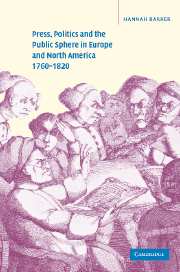Book contents
- Frontmatter
- Contents
- Notes on contributors
- Acknowledgements
- Introduction
- 1 The cosmopolitan press, 1760–1815
- 2 The Netherlands, 1750–1813
- 3 Germany, 1760–1815
- 4 England, 1760–1815
- 5 Ireland, 1760–1820
- 6 America, 1750–1820
- 7 France, 1750–89
- 8 The French revolutionary press
- 9 Italy, 1760–1815
- 10 Russia, 1790–1830
- Index
5 - Ireland, 1760–1820
Published online by Cambridge University Press: 05 July 2009
- Frontmatter
- Contents
- Notes on contributors
- Acknowledgements
- Introduction
- 1 The cosmopolitan press, 1760–1815
- 2 The Netherlands, 1750–1813
- 3 Germany, 1760–1815
- 4 England, 1760–1815
- 5 Ireland, 1760–1820
- 6 America, 1750–1820
- 7 France, 1750–89
- 8 The French revolutionary press
- 9 Italy, 1760–1815
- 10 Russia, 1790–1830
- Index
Summary
In its earliest years, perhaps through to 1760, the Irish newspaper was in many respects close to the model propounded by Jürgen Habermas. Intimately associated with learned societies and debating clubs on the one side, and with coffee shops, booksellers and other commercial enterprises on the other, it was inextricably linked to the literary and political spheres. As well as philosophical and moral essays it contained practical disquisitions on developmental issues, verse and belles lettres, and occasionally political polemic. Jonathan Swift, Dean of St Patrick's, who was a leading politician and propagandist, as well as a literary lion, and who patronised and utilised the press and maintained close ties to it, was a symbol of its aspirations, if not, perhaps, of its achievements. A century and more later, when, in 1833, the foundation of the Dublin University Magazine again brought together many of Ireland's best intellects in both the literary and political spheres, much of the early promise remained unrealised. The Irish newspaper press was not a failure, and indeed even in its darkest hours retained a vigour and freedom which would have been found astonishing in many parts of Europe. It was rather that it had developed less than might have been anticipated. It was still dominated by small-scale family enterprises of marginal profitability and tenuous viability. Its influence, in the political sphere, which admittedly had changed markedly, was still limited and uneven.
- Type
- Chapter
- Information
- Publisher: Cambridge University PressPrint publication year: 2002

